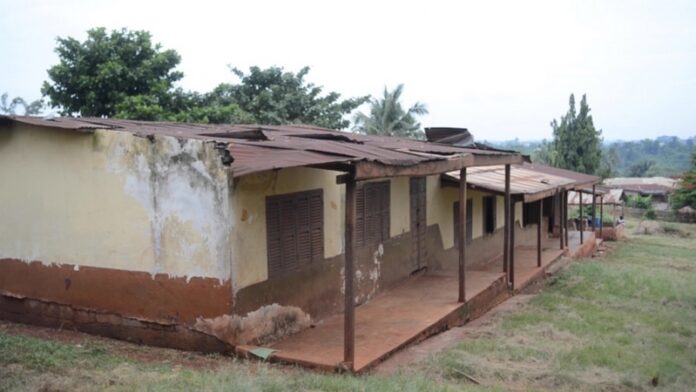Deep within the Western North Region, in the Wiawso Municipality, lies Okomdom, a community that pulses with the quiet rhythm of rural life. At its centre stands Okomdom M/A Junior High School (JHS), a school that has weathered the passage of time but now stands as a shadow of its former self.

Once a vibrant hub of learning, the school now battles the harsh reality of neglect, its walls whispering the stories of a past filled with promise and a future in peril.
A walk-through time
The entrance to Okomdom M/A JHS is flanked by timeworn pillars that have seen better days. As you walk through the school grounds, it’s easy to imagine the scene from decades past: children in crisp uniforms, their voices mingling in a lively chorus as they move between classes. But today, the once-thriving corridors echo only with the quiet footsteps of a few remaining students, the vibrancy replaced by an air of desolation.

Edith Nketsia, a former student turned teacher, stands by one of the crumbling classroom blocks, her eyes reflecting a mix of nostalgia and sorrow. “Twenty years ago, this school was bustling with life,” she says, her voice tinged with emotion. “It was a privilege to be here, but now… just look at it.”

She gestured towards the building with walls cracked, paint peeling, and windows broken. The roof sags under the weight of neglect, threatening to collapse at any moment. “This used to be a double-stream school, A and B,” Edith explains, “but the deterioration forced us to combine the streams. Now, we barely have enough students to fill one class.”

The struggles within
Inside the classrooms, the scene is equally grim. Wooden desks, worn and battered, are crammed together, leaving little room for the students who huddle inside. The walls are bare, save for a few faded posters clinging to the plaster. The air is thick with the scent of dampness, a reminder of the building’s fragile state.

Manso Adjei, a teacher at the school, shakes his head as he surveys the room. “We face so many challenges here,” he says. “The canteen is in such poor condition that students eat in their classrooms. We don’t even have proper benches for them to sit on. And the toilets… they’re barely functional. It’s not a conducive environment for learning, but we have no choice.”
Manso points out another pressing issue, the lack of a primary school to feed the JHS. “At first, Okomdom M/A JHS was a double-stream school,” he says. “But with no primary school, we have to take in students from other schools. Often, these students come in with low academic performance, and we have to accept them just to keep the school running.”

In the corner of the classroom, a young girl named Abena quietly shares her thoughts. “I love coming to school, but it’s hard sometimes,” she says, her voice barely above a whisper. “There aren’t enough books, and the building makes me scared when it rains. I just want to learn in a safe place.”

Fading hope, growing resolve
Despite the overwhelming challenges, there is a flicker of hope among the ruins. Edith and other alumni of the school have taken it upon themselves to rally support. They have organized fundraisers, reached out to old students, and even managed some minor renovations. But these efforts, while commendable, are not enough to save the school.
“We’ve started mobilizing,” Edith says, a determined look on her face. “We’ve reached out to those who studied here, asking them to help. But what we really need is a complete overhaul for a new building, a primary school, and the resources to give these children the education they deserve.”

The students, too, hold onto hope. Kwame, another student, dreams of becoming a teacher one day. “I want to help my community,” he says, “but I worry that by the time I’m old enough, there won’t be a school left.”
A call to action
Okomdom M/A JHS is more than just a school; it is the heart of the community. It has nurtured generations of students, many of whom have gone on to make significant contributions to society. But without intervention, this institution will fade into obscurity, taking with it the dreams of countless children.
The school’s survival depends on the support of the government, corporate entities, traditional leaders, and individuals willing to invest in the future of these students. The current state of the school is a stark reminder of the challenges facing rural education in Ghana, but it is also a call to action, an urgent plea for help.
As Edith, Manso, and the students of Okomdom M/A JHS continue their daily struggles, they do so with the hope that their voices will be heard. They dream of a day when the school will once again thrive, its classrooms filled with the sounds of learning, its walls strong and secure.
The future of Okomdom M/A JHS lies in the hands of those who are willing to listen, act, and give these children the chance they deserve. The echoes of its past call out, asking us to rebuild, renew, and restore hope.
The story of Okomdom M/A JHS is not just about a school in need; it’s about the resilience of a community and the enduring spirit of its people. It’s about the power of education to transform lives and the responsibility we all share in ensuring that this transformation continues.
Let us answer the call, not just with words, but with action. Together, we can rebuild Okomdom M/A JHS and secure a brighter future for the children who call it home.
Source: Ina-Thalia Quansah/JoyNews

